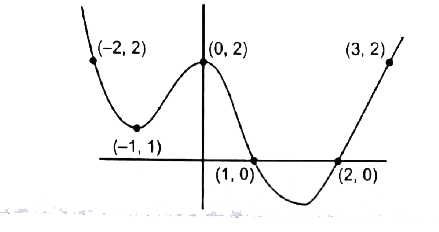In the given figure graph of :
y=p(x)=xn+a1xn−1+a2xn−2+…..+an is given.
![In the given figure graph of : y =p (x) = x ^(n)+a(1) x ^(n-1) +a(2) x ^(n-2)+ …..+ a (n) is given. If p (x) + k=0 has 4 distinct real roots alpha, beta, gamma,delta then[alpha]+[beta]+[gamma]+[delta], (where [.] denotes greatest integer function) is equal to:](https://d10lpgp6xz60nq.cloudfront.net/physics_images/BLJ_VKG_MAT_C04_E03_010_Q01.png)
If p(x)+k=0 has 4 distinct real roots α,β,γ,δ then[α]+[β]+[γ]+[δ], (where [.] denotes greatest integer function) is equal to:
−1
−2
0
1
The correct Answer is:A
Step by step video & image solution for In the given figure graph of : y =p (x) = x ^(n)+a_(1) x ^(n-1) +a_(2) x ^(n-2)+ …..+ a _(n) is given. If p (x) + k=0 has 4 distinct real roots alpha, beta, gamma,delta then[alpha]+[beta]+[gamma]+[delta], (where [.] denotes greatest integer function) is equal to: by Maths experts to help you in doubts & scoring excellent marks in Class 12 exams.
Updated on:21/07/2023Topper's Solved these Questions
- APPLICATION OF DERIVATIVES BOOK - VIKAS GUPTA (BLACK BOOK) ENGLISHCHAPTER - APPLICATION OF DERIVATIVES EXERCISE - EXERCISE (MATHCING TYPE PROBLEMS)
6 Videos
- APPLICATION OF DERIVATIVES BOOK - VIKAS GUPTA (BLACK BOOK) ENGLISHCHAPTER - APPLICATION OF DERIVATIVES EXERCISE - EXERCISE (SUBJECTIVE TYPE PROBLEMS)
22 Videos
- APPLICATION OF DERIVATIVES BOOK - VIKAS GUPTA (BLACK BOOK) ENGLISHCHAPTER - APPLICATION OF DERIVATIVES EXERCISE - EXERCISE (ONE OR MORE THAN ANSWER IS/ARE CORRECT )
29 Videos
- AREA UNDER CURVESBOOK - VIKAS GUPTA (BLACK BOOK) ENGLISHCHAPTER - AREA UNDER CURVESEXERCISE - AXERCISE (SUBJECTIVE TYPE PROBLEMS)
8 Videos
Similar Questions
In the given figure graph of :
y=p(x)=xn+a1xn−1+a2xn−2+…..+an is given.

The product of all imaginary roots of p(x)=0 is:
View SolutionIf p''(x) has real roots α,β,γ. Then , [α]+[β]+[γ] is

View SolutionIn the given figure graph of :
y=p(x)=xn+a1xn−1+a2xn−2+…..+an is given.

The minimum number of real roots of equation (p'(x))2+p(x)p''(x)=0 are:
View SolutionLet α,βandγ be the roots of equation f(x)=0 , where f(x)=x3+x2−5x−1=0. then the value of |[α]+[β]+[γ]|,where[.] denotes the integer function, is equal to
View SolutionIf the centroid of triangles formed by the vertices (1, 2, 3), (2, 1, 0) and (3, 1, 4) is (α,β,γ) then the value of
[α]+[β]+[γ], where [ ] represents the greatest integer function, is _______.
View SolutionIf the function f(x)=x3−9x2+24x+c has three real and distinct roots α,βandγ, then the value of [α]+[β]+[γ] is
View SolutionLet f(x)=(x2−3x+2)(x2+3x+2)andα,β,γ satisfy α<βγ are the roots of f'(x)=0 then which of the following is/are correct ([.] denots greatest integer function) ?
View SolutionIf α,β,γ are the roots of x3+x2−5x−1=0 then α+β+γ is equal to
View SolutionLet n be positive integer such that, (1+x+x2)n=a0+a1x+a2x2+….+a2nx2n, then ar is :
View SolutionIf 2x3+3x2+5x+6=0 has roots α,β,γ then find α+β+γ,αβ+βγ+γα and αβγ
View Solution